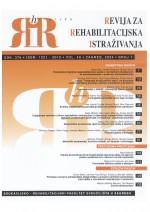Komunikacija u obitelji - percepcija djece i mladih
Family communication - the perception of children and youth
Author(s): Martina Ferić, Antonija ŽižakSubject(s): Theory of Communication, Family and social welfare, Inclusive Education / Inclusion
Published by: Sveučilište u Zagrebu, Edukacijsko-rehabilitacijski fakultet
Keywords: family communication; children and youth; behavioral disorders;
Summary/Abstract: The study encompassed the perception of the context, function and types of interpersonal communication in the examined sample families as well as the dfferences in the perception of family communication patterns in the families with dfferent living conditions (families of primary and high school students, welfare users and children and youth treated in special institutions for children and youth with behavioral disorders). The aim of the paper was to examine and describe children's perception of their family communication, and to determine whether there are any dfferences in the perception of family communication regardless of their socio-family status. The hypotheses were, on the basis of prior knowledge and literature on the subject, that family communication would be seen as more positive in those groups of children that, by usual classification, belong to the so called general population". The sample consisted of 1,407 children and youth aged ll-18. The sample was questioned about the form of communication within their families. The questionnaire Communication in the Family (Brajia, P., Baiit, J., Mejoviek, M., Ziiak, A.) was used for the purpose. Factor analyses and robust discriminative analysis were used for data processing. The results showed that, in children's estimation, communication within the family covered a wide part of family life, and the social function of the family was specially recognized. The most significant difference was, in the estimation of the children,family togetherness (with special emphasis on support and help) with the absence of unclear and closed communication. The results obtained may serve as a basis for professional suggestions in respect to the prevention and treatment of children and youth with behavioral disorders.
Journal: Hrvatska revija za rehabilitacijska istraživanja
- Issue Year: 39/2004
- Issue No: 1
- Page Range: 25-37
- Page Count: 13
- Language: Croatian

